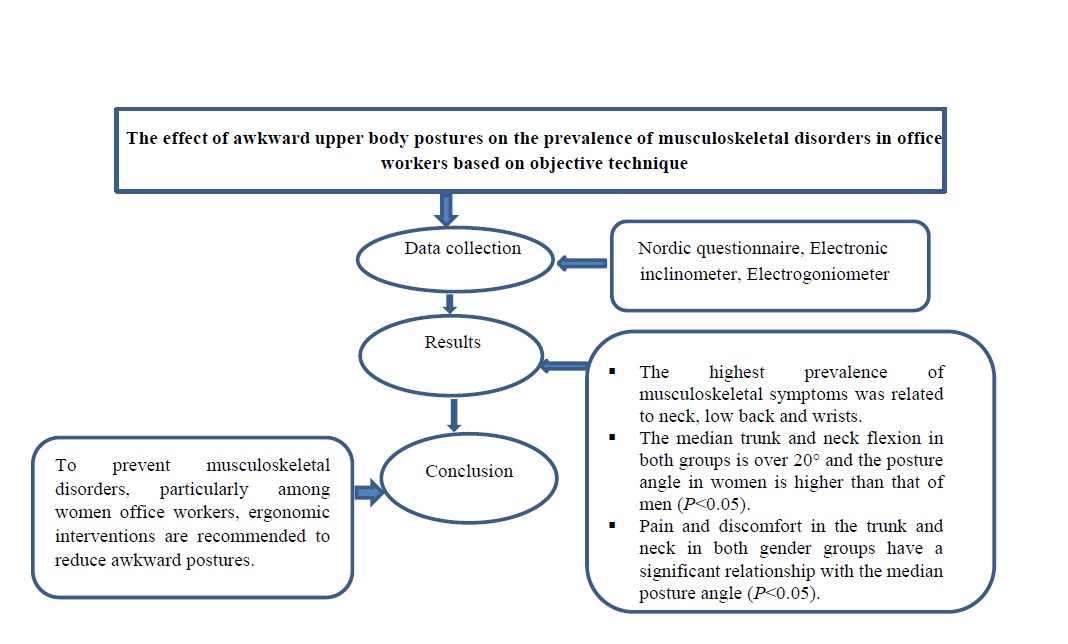Volume 13, Issue 4 (12-2023)
J Health Saf Work 2023, 13(4): 685-700 |
Back to browse issues page
Download citation:
BibTeX | RIS | EndNote | Medlars | ProCite | Reference Manager | RefWorks
Send citation to:



BibTeX | RIS | EndNote | Medlars | ProCite | Reference Manager | RefWorks
Send citation to:
Nourollahi-Darabad M, Afshari D, Mohipour S, Shirali G. The Effect of Awkward Upper Body Postures on the Prevalence of Musculoskeletal Disorders in Office Workers Based on Objective Techniques. J Health Saf Work 2023; 13 (4) :685-700
URL: http://jhsw.tums.ac.ir/article-1-6904-en.html
URL: http://jhsw.tums.ac.ir/article-1-6904-en.html
1- Department of Occupational Health, School of Health, Alborz University of Medical Sciences, Karaj, Iran
2- Department of Occupational Health Engineering, School of Public Health, Ahvaz Jundishapur University of Medical Sciences, Ahvaz, Iran ,davodafi@yahoo.com
3- Department of Occupational Health Engineering, School of Public Health, Ahvaz Jundishapur University of Medical Sciences, Ahvaz, Iran
2- Department of Occupational Health Engineering, School of Public Health, Ahvaz Jundishapur University of Medical Sciences, Ahvaz, Iran ,
3- Department of Occupational Health Engineering, School of Public Health, Ahvaz Jundishapur University of Medical Sciences, Ahvaz, Iran
Abstract: (933 Views)
Introduction: Musculoskeletal disorders (MSDs) have a multifactorial nature. Biomechanical factors are one of the most important factors. Consequently, the precise identification of effective factors plays a significant role in controlling and preventing these disorders. Therefore, the current study aimed to identify the awkward upper body postures and their effect on the prevalence of MSDs in office workers in both women and men groups by objective methods.
Material and Methods: In this cross-sectional study, the participants were 36 office workers (18 women and 18 men). The prevalence of musculoskeletal discomfort was evaluated using the Nordic questionnaire. The upper limbs posture, including the back, neck, and wrists, was evaluated continuously with an electronic inclinometer and an electrogoniometer for 30 min, followed by analyzing the collected data.
Results: The results revealed that the highest prevalence of musculoskeletal symptoms in both gender groups was in the neck (58.33%), trunk (52.77%), and wrist (47.22%), respectively. The results disclosed that the median trunk and neck flexion in both groups is over 20° and the posture angle in women is higher than that of men (P<0.05). The results showed that pain and discomfort in the trunk and neck in both gender groups have a significant relationship with the median posture angle (P<0.05). Also, the wrist posture in both gender groups during work was in extension and static condition.
Conclusion: Based on the results of this study, the prevalence of disorders in women was higher than in men. Although the tasks performed in both groups were similar, the assessment of postures disclosed that women office workers had more awkward postures in the trunk and neck than men. In both groups, the prevalence of musculoskeletal discomfort had a significant relationship with awkward postures in the trunk and neck. According to the results of the current study, ergonomic interventions are recommended to reduce awkward postures and to prevent MSDs, particularly among women office workers.
Material and Methods: In this cross-sectional study, the participants were 36 office workers (18 women and 18 men). The prevalence of musculoskeletal discomfort was evaluated using the Nordic questionnaire. The upper limbs posture, including the back, neck, and wrists, was evaluated continuously with an electronic inclinometer and an electrogoniometer for 30 min, followed by analyzing the collected data.
Results: The results revealed that the highest prevalence of musculoskeletal symptoms in both gender groups was in the neck (58.33%), trunk (52.77%), and wrist (47.22%), respectively. The results disclosed that the median trunk and neck flexion in both groups is over 20° and the posture angle in women is higher than that of men (P<0.05). The results showed that pain and discomfort in the trunk and neck in both gender groups have a significant relationship with the median posture angle (P<0.05). Also, the wrist posture in both gender groups during work was in extension and static condition.
Conclusion: Based on the results of this study, the prevalence of disorders in women was higher than in men. Although the tasks performed in both groups were similar, the assessment of postures disclosed that women office workers had more awkward postures in the trunk and neck than men. In both groups, the prevalence of musculoskeletal discomfort had a significant relationship with awkward postures in the trunk and neck. According to the results of the current study, ergonomic interventions are recommended to reduce awkward postures and to prevent MSDs, particularly among women office workers.
Type of Study: Research |
Received: 2024/01/1 | Accepted: 2023/12/31 | Published: 2023/12/31
Received: 2024/01/1 | Accepted: 2023/12/31 | Published: 2023/12/31
Send email to the article author
| Rights and permissions | |
 |
This work is licensed under a Creative Commons Attribution-NonCommercial 4.0 International License. |






